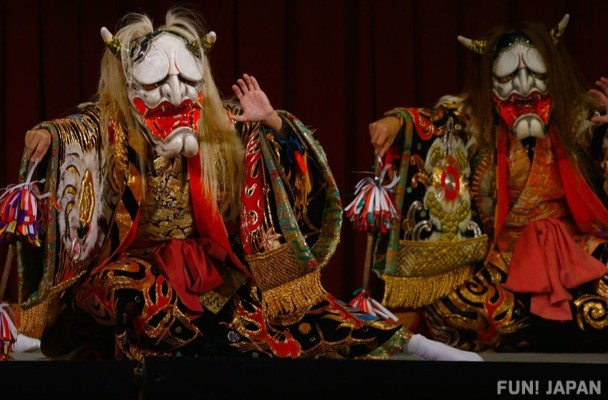
Combining legends, gods, ancient myths and customs, Japanese Mythology is a world of intrigue, supernatural powers and wonder. Tales combine elements of Buddhism with the nature-focused Shintoism, moving from celestial gods to the creation of Japan’s first emperor. As well as appearing in ancient texts, mythological tales can be seen in kagura (Shinto performances), Kabuki and Noh theater performances.
What is Mythology?

Mythology is defined as a form of narrative featuring gods and supernatural beings, believed to relate to real events. There are often ties to religious beliefs, with a symbolic nature and many characters. Common and well known ancient mythologies include the Greek Myths and the Welsh Mabinogi, with both containing moralistic tales of creation, with supernatural elements. In Japan, the mythology focuses largely on the creation of the islands, the creation and powers of Gods and is strongly revered.
Where does Japanese Mythology Come From?

Japan’s complex mythology is a unique combination of different cultures, religions and histories. There are elements of the country’s two primary religions - Shinto and Buddhism, as well as influences from China and India, all combined with indigenous elements from Japan’s oldest inhabitants, the Ainu of the north and the Ryukyuan people of Okinawa. While originally oral tales or told through song, there are written versions of the myths and legends kept for posterity, either in national annals or in collections of verse or stories.
The Kojiki and the Nihon Shoki
These two important texts are the oldest records of Japanese mythology. As they were written to provide records of Japan and strengthen the history of the ruling class, they have a political element and are not purely mythological in content, but provide string histories of the national tales.
The Kojiki - meaning ‘record of ancient matters’ is a compilation of oral folklore recorded in 712. The contents include myths, legends and tales from the imperial court and is vital for the continuation of traditional ceremonies and customs. There is a popular companion called the Annotation of the Kojiki which was written in the late 18th century.
The Nihon Shoki, meaning ‘Chronicles of Japan’ contains the oldest official history of the nation, from mythical beginnings to the year 697. It was compiled in 720 to provide a court history as impressive as that of the Chinese courts, and was continued with six further volumes up to 887. It details the myths and legends of Japan, the influence of the Chinese, the Taika reforms and the introduction of Buddhism to Japan, making it a key text for understanding how Japan developed in its early years.
Japan’s Creation Story and its Famous Mythical Characters

Many different stories are involved in the creation myth, with a strong focus on ceremony and purification with darker topics such as infanticide and death running throughout. There are two primary cycles in legends: the Yamato Cycle and the Izumo Cycle. The former centers on the Sun Goddess Amaterasu and the former on her sibling the Sea God Susano no Mikoto.
Izanagi and Izunami: The Gods and Islands
There are two key elements in the creation of Japan: kamiumi, the birth of the deities, and kuniumi, the birth of the land. Originally, the world was a place of chaos, but eventually divided into two parts - the finer became a kind of heaven (yang) and the heavier parts became earth (yin). To begin, three gods appeared from primordial oil, with one forming a reed between the two parts - they produced seven generations of gods, seen as divine couples, but in some texts as siblings.
One such couple was Izanagi and Izanami (meaning he who invites and she who invites, respectively). They were ordered to stand on a bridge above the ocean and stir with a spear, lifting it up and using the dripping brine to create Onogoro, the first island. They descended to the island and produced eight children, who become the many islands of the Japanese archipelago. While giving birth to a fire god, Izanami is killed with the distraught Izanagi murdering their child in revenge. The myths continue, detailing Izanagi’s attempts to rescue Izanami from Yomi, the Japanese underworld. Although he finds her, she says she cannot leave as she has already eaten food cooked on a stove in Yomi, and despite her warning, he looks at her and sees her true, maggot-infested form, fleeing immediately. Humiliated, she chases him from the underworld, only to find he has blocked her path with a stone. This forms the first divorce, and he purifies himself from the underworld.
Amaterasu O-Mikami: The Sun Goddess of the Yamato Cycle
As Izanagi washes in his purification ceremony, a tear that falls from his left eye forms the sun Goddess Amaterasu Omikami, who is seen as the ancestor of the Imperial Family. Amaterasu is one of the most important deities of the Shinto religion, and rules over Takamagahara, the ‘high celestial plains’ - the home of all gods. One of three gods produced during the ceremony, she is connected to Tsukuyomi no Mikoto, god of the moon, who falls from the right eye, and Susanoo, the god of the sea, who falls from their fathers nose.
Before leaving for their planes, she produced children in a sword and jewel ceremony with Susanoo, who then became abusive, disrespecting her home and throwing a flayed horse into her weaving room. In protest, Amaterasu withdrew into a cave, leaving the world in darkness. The 800 gods convened, devising a plan to draw her out which involved a mirror and cockerels. It was not until a spontaneous dance by the goddess of dance, Amenozume drew so much laughter from the gods, however, that Amaterasu was drawn out in curiosity, and a Shimenwa (a rice straw rope) was thrown across the cave to stop her returning.
Amerterasu’s primary shrine is the Grand Shrine of Ise, which is the most sacred shrine in Japan. It holds the mirror, while the sword is said to be kept in Atsuta Grand Shrine in Aichi prefecture and the jewel which is kept by the Emperor - all three are Imperial treasures of Japan.
Susanoo no Mikato: The Sea God of the Izumo Cycle
There are many tales of the trickster god Susanoo, who was ruler of the seas. After his behaviour with Amaterasu, Susanoo was banished from heaven, returning to Izumo. He rescued a beautiful princess, Kushiinada Hime, from an eight headed serpent known as Yamata no Orochi. His marriage to the princess meant his child, Okuninushi, became the ruler of Izumo, long before the arrival of the Amaterasu’s descendants. When the sun Goddess requested that Izumo be ruled by descendants of celestial gods, rather than earthly gods, her grandson was given sacred rice and told to grow crops and worship the gods of heaven. He married the god of the mountain, with one of their three sons becoming the father of the first legendary emperor, Jimmu, who moved Japan from the age of Gods to the historical age.

Comments